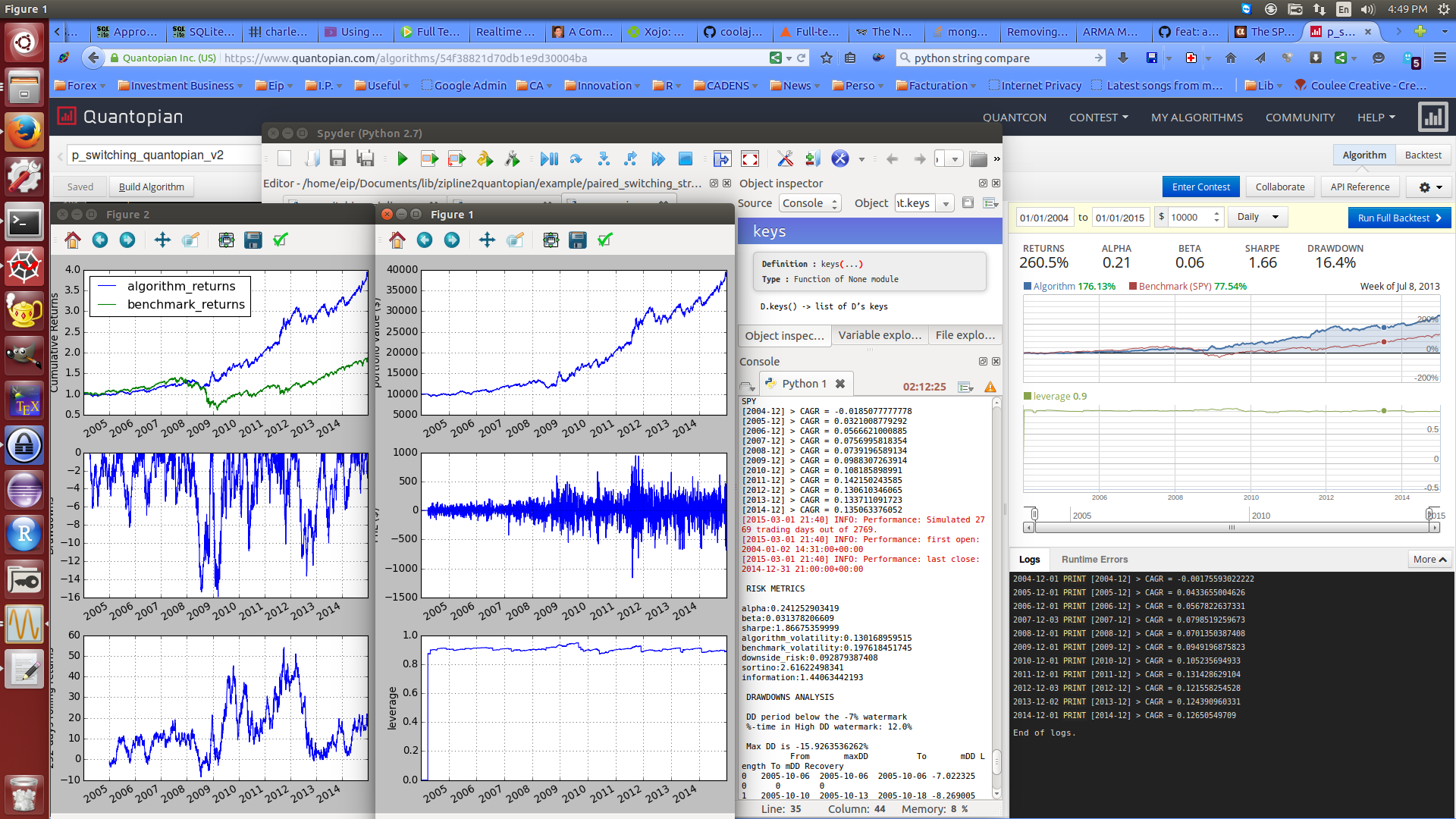Quantopian provides a web-framekwork for the design, backtesting, paper trading and live trading of Automated Trading Systems (ATS) written in python. Specifically, Quantopian provides an infrastructure that hides the complexity of the backend required to live trade ATS coded in python through Interactive Brokers.
In addition to its web-framework, Quantopian open sourced its ATS engine under Zipline, a local python framework enabling ATS design and backtesting (live trading components are not open sourced, although they could be developped).
Nonetheless, Quantopian does not provide yet an IDE where multiple files could be used while designing a python strategy (unlike QuantConnect). In other words, to be traded live a given ATS must be provided as a single file. As well, Quantopian does not provide yet efficient debugging solutions. Both limitations could be addressed by leveraging the Zipline framework in a linux environment, specifically using the Sypder IDE for coding python solutions. Using Spyder one may benefit from powerful interactive development environment for the Python language with advanced editing, interactive testing, debugging and introspection features.
The initial objective was to address the need to translate automatically Spyder/Zipline-compatible ATS into Quantopian-compatible (single file) code, and support diligent ATS design and validation. Specifically, by diligent I mean logging relevant information from a strategy's analytics, type and size of orders (or a combination of strategies), for subsequent validation and verification after improvements, bug corrections or code enhancements.
-
A primary purpose for this repo is to provide a linux skeleton enabling Spyder-compatible ATS. Specifically, said skeleton should allow for running the ATS from within the Spyder IDE, while making the most of its debugging feature.
-
A secondary purpose is to provide a linux script enabling the automated generation of Quantopian compatible ATS (single-file), from a strategy designed in Zipline and using the proposed seleton (involving multiple files).
A second objective was to provide some educative ATS strategies written in Zipline and compatible with Quantopian, or Quantopian-only code snippets, demonstrating the use of the proposed skeleton and associated script generating a Q-compatible singleton.
A rational for the proposed skeleton structure is detailed in skeleton_structure.md
[note] a cleaner way would be to create a package structure such as:
zipline2quantopian
./quantopian ; output for script
./zipline
./zipline/global_import
./zipline/strategies ; containing the core of the strategies
./zipline/main ; containing the main used in spyder only
./zipline/generic_module
./zipline/TradingArchitecture ; containing the backend for managing multiple strategies in an orderly fashion.
Such directory tree shall enhance the script creating the Q-compatible output by automatically parsing directories, and generating proper filename for quantopian output. Currenlty, I cannot make the import work in such module structure !@#$
[TESTED ON LINUX AND WINDOWS]
Usage: ./generate_quantopian.sh [-h?] [-o OUTFILE] [-s CORE STRATEGY DIRECTORY] [-i IMPORT DIRECTORY] [-m list any additional directories ...]
- -h/? display this help and exit
- -c FILENAME configuration file: can be used to input all other parameters; advantage is to use the "exclude filter"
- -o OUTFILE quantopian files generated from zipline
- -s DIR main strategy classes
- -i DIR global imports containing zipline and quantopian imports. DEFAULT is ./global_import
- -m DIR Any additional directory containing relevant classes. DEFAULT is ./generic_modules
EXAMPLE-1: ./generate_quantopian.sh -o strategy_quantopian.py -s ./strategy -i ./global_import -m ./generic_modules
EXAMPLE-2: ./generate_quantopian.sh -c strategy_conf.z2q, where *.z2q is a JSON file containing the following:
{
"z2q_conf":{
"output_file": "strategy_quantopian.py",
"dir_strategy": "strategy/",
"dir_quantopian_import": "global_import/",
"dir_generic_func": ["generic_modules/", "...add more.../"],
"exlude_modules":["custom_data.py", "...add more....py"]
}
}
I would suggest to symlink the skeleton structure of the git-pull repo during your strategy design, in order to maintain separately the skeleton elements (benefiting from updates and retaining the ability to commit improvements), and your private strategies' elements. You may use the following command:
$ ln -s ../../lib/zipline2quantopian/skeleton/* ./
To create the example directory, I did create the strategy directory, then $ ln -s ../../skeleton/ ./* into it, and further add the strategy directory and main zipline file.
The Skeleton directory contains the minimal files structure necessary to realize the previous objectives. Although it can easily be expanded (more files and more directories), kindly note that the automatic aggregation of multiple files into a single quantopian-compatible ATS should respect the stated design requirements.
Except for the Quantopian only director, the Example directory contains functional ATS examples, written in a manner compatible with the proposed skeleton. The ATS is thus compatible with Zipline, and can be automatically exported in a single file compatible with Quantopian. The ATS are
- Paired-switching for tactical portfolio allocation, reference paper.
- multi-strategy with multiple instruments, where strategies are most simplistic momentum strategies, for the sole benefit to demonstrate how to combine different ATS in a single strategy.
If we take the example of the Paired-switching ATS, the p_switching_quantopian.py quantopian script was obtained by the following command-line:
$ ./generate_quantopian.sh -o p_switching_quantopian.py -s ./p_switching/ -i ./global_import/ -m ./generic_modules/
The comparison between zipline and quantopian backtests is as follows:
Workflow: Using that of GitHub Flow
Branch naming conventions shall follow that of GroupName/Info:
- Use grouping names at the beginning of your branch names.
- Define and use short lead tokens to differentiate branches in a way that is meaningful to your workflow.
- Use slashes to separate parts of your branch names.
- Do not use bare numbers as leading parts.
- Avoid long descriptive names for long-lived branches.
Grouping Names: Short and well-defined group names (used to tell you to which part of your workflow each branch belongs):
- wip Works in progress; stuff I know won't be finished soon
- feat Feature I'm adding or expanding
- bug Bug fix or experiment
- junk Throwaway branch created to experiment
ADAPTIVE PUBLIC LICENSE V1.0 as stated in LICENSE.txt with its supplement file SUPPFILE.txt.
Why APL V1.0? It provides the means for the initial contributor to specify his/her intention by fine-tuning parts of the license. In addition, section 3.6 grants independent modules with separate license agreements which opens broad alternatives for any contributors beyond that of other so-called viral licenses.
REFER TO Investment Disclaimer, Risks and Warnings FOR DETAILS.
